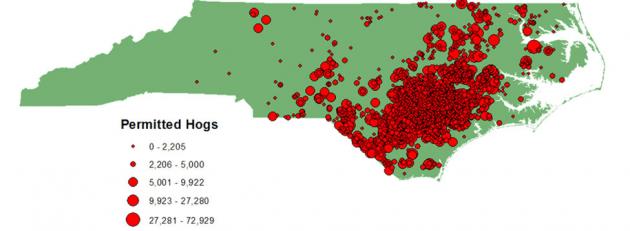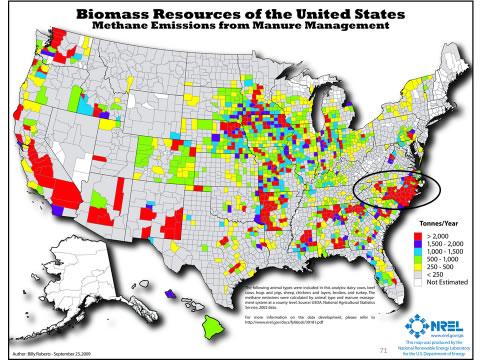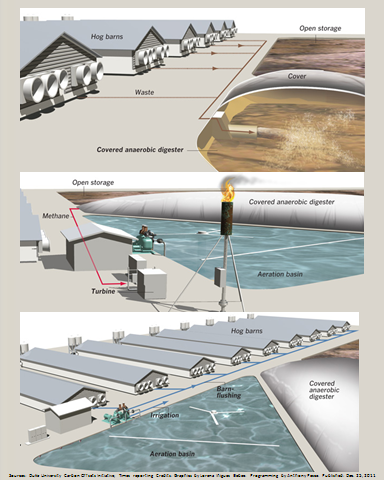Why Study Organic Wastes as Energy Sources?
Compare the Potential: The United States has tremendous organic resources available, such as food waste, crop residues, animal manures, and human waste. Americans need only look out the window of their home or office to see the reasons why – we live in a very ‘green’ country. In most states, we have a temperate climate with ample resources that promotes our ability to inhabit and cultivate; which means we create organic wastes. However, Americans have been slow to realize the huge potential that may be derived from these organic resources in the form of bioenergy. Why have we spent so much time evaluating the energy resources buried deep in our soils, rather than recognizing the opportunity right in front of us, above the dirt?
What did we do?
This presentation provides an overview for establishing infrastructure systems that capture, purify, and transport the biogas that may be derived from these organic resources to create an infinite energy reserve to draw from, creating jobs and bolstering our economy. Potential uses for energy products that may be derived from organic wastes are discussed, as well as the barriers, challenges, and economics of waste to energy systems. The presenter’s home state of North Carolina is examined in more detail, describing and comparing the potential for harnessing the energy value from wastes that lie above the dirt.
The Potential:
To understand the infinite possibilities and advantages of the use of bioenergy nationwide, let’s first explore the possibilities in just one state, North Carolina. According to Census Bureau migration patterns in 2013 across the U.S. showed that North Carolina remains in the top 3 fastest-growing states in the nation. While predominantly an agricultural state, N.C. has an abundance of potential to be derived from organic resources in the form of bioenergy. N.C. places second in the U.S. for the production of pigs and turkeys and it ranks fourth in the production of broiler chickens. This generates an abundance of organic wastes, particularly in animal manures, which as people are beginning to understand, gives our state of North Carolina the potential to be a leader in supplying renewable energy.

According to sources such as the Environmental Protection Agency (EPA), the U.S. Department of Agriculture (USDA) and the Renewable Energy Laboratory (NREL), the organic waste resources in North Carolina – stemming from municipal waste (solid waste and sewage) and agriculture (animal manures) – are among the richest in the nation. Imagine the Potential: North Carolina can harvest energy value from crop residues, food waste and crops to produce infinitely renewable energy that can also improve air and water quality impacts. Anaerobic digestion is one common approach to harvesting the energy content of these organic wastes and other feedstocks.

What have we learned?
The development of bioenergy systems is one of the ways in which we can be good stewards of our earthly resources. By reusing the carbon readily at hand above the ground – which is often already creating a negative environmental impact in the form of waste – these bioenergy systems can provide for our fuel and energy needs while simultaneously achieving improvements in environmental quality. There are many ways in which we can accomplish the reuse of carbon through the harvesting of energy value associated with organic wastes. There are over 16,000 permitted municipal WWTP’s in the U.S., and about 10% utilize anaerobic digestion. Coupled with the thousands and thousands of farms, landfills, and biotechnology manufacturing facilities, our ability to develop renewable biogas fuels for transportation and electrification is astounding.

Future Plans
As a country we need to step away from how we have always done things (buying foreign sources of oil, and using fossil fuels, and relying solely on power plants) and be receptive to innovative approaches that improve climate action initiatives and foster stewardship of our earthly resources so that we can do better environmentally and plan so there be enough water, energy and food for the future. These recommendations start on a state to state level, and progress through our country, and across the world. We need to take better care of our environment, and uses our resources to reduce pollution and greenhouse gases, and harvest the energy from our wastewater and agricultural sources that lie above the dirt.
Author
Gus Simmons, P.E., Director of Bioenergy, Cavanaugh & Associates, P.A. gus.simmons@cavanaughsolutions.com
Additional information
1-877-557-8924
Acknowledgements
Duke Energy Carbon Offsets Initiative
NREL – www.nrel.gov/gis
The authors are solely responsible for the content of these proceedings. The technical information does not necessarily reflect the official position of the sponsoring agencies or institutions represented by planning committee members, and inclusion and distribution herein does not constitute an endorsement of views expressed by the same. Printed materials included herein are not refereed publications. Citations should appear as follows. EXAMPLE: Authors. 2015. Title of presentation. Waste to Worth: Spreading Science and Solutions. Seattle, WA. March 31-April 3, 2015. URL of this page. Accessed on: today’s date.

